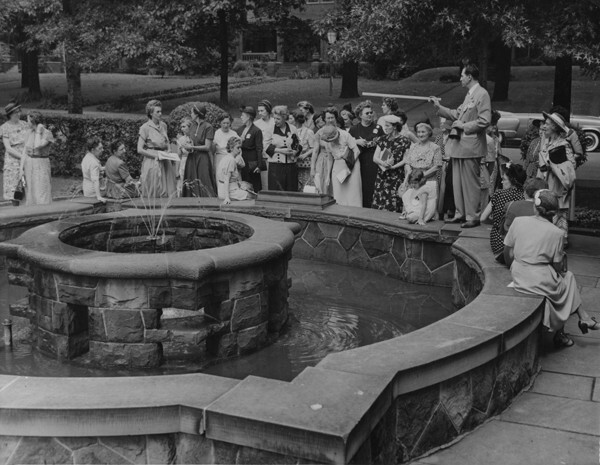Lithuanian Cultural Garden

Dedicated in October 1936, the Lithuanian Cultural Garden extends from East Boulevard down three levels to Martin Luther King Boulevard. Designed by Professor Dubinecras in Lithuania, the garden was adjusted by the City Plan Commission of Cleveland to fit the local topography. The Lithuanian Cultural Garden's choice of sculptures reflects the importance of national identity in the construction of many of the cultural gardens. Designed in the shape of a lyre, the Lithuanian delegations explicitly organized the landscape into three levels, to represent three moments in Lithuanian history and its struggle for national identity.
The central feature of the garden's upper level is the Fountain of Biruta. Biruta was a priestess in the Temple of Perkunas, the God of Thunder and/or Oak. Two nooks frame the upper-level's fountain and terrace, each nook possessing a bust of a figure that is closely associated with Lithuanian national identity. On one side of the garden is a bronze bust of Vincas Kudirka, a poet, physician and composer of the Lithuanian National Anthem (1858-1899). This bust was dedicated in 1938. On the opposite side of the garden stands a bust of Maciulis Maironis, a priest whose poetry advanced the cause of Lithuanian independence (1862-1932). This bust was dedicated in 1961.
The middle level of the garden is a terrace defined by a three pillared sculptured wall that towers above the garden's lower level. The wall was modeled after the three pillars of Gediminas, which is a commemorative memorial in Vilnius symbolizing the unification of Lithuania.
The lowest level runs along MLK Boulevard. It tells the story of Lithuania's rebirth after World War I through the dominating bust of Dr. Jonas Basanavicius (1851-1927), a scholar, historian, and first president of the Lithuanian Republic in 1918. Dedicated in 1936, the bust was a gift of the Lithuanian government. According to Clara Lederer, both the Basanavicius and Kudirka busts were copies of originals created by prominent Lithuanian sculptor Jonas Zikaras, whose work championed Lithuanian national identity.
The first Lithuanians were recorded in Cleveland in 1871. They formed settlements around St. Clair and Oregon Ave (now Rockwell), ranging east to about E. 71st St. between Oregon and Cedar Avenues. By 1930 approximately 10-12,000 Lithuanians lived in Cleveland. The growing community continued to expand east to the Collinwood area. Around 4,000 Lithuanian refugees immigrated to Cleveland after World War II. By 1973, a new community center called Lithuanian Village was built and dedicated along E. 185th Street. Community activity quickly shifted to that area.
The Lithuanian community presently numbers about 16,000. The re-establishment of Lithuanian Independence in the early 1990s had a monumental impact on the community. There has been a modest level of new immigration since then, and some members of the Cleveland community have established business ties with the Republic of Lithuania.
Audio
Images





